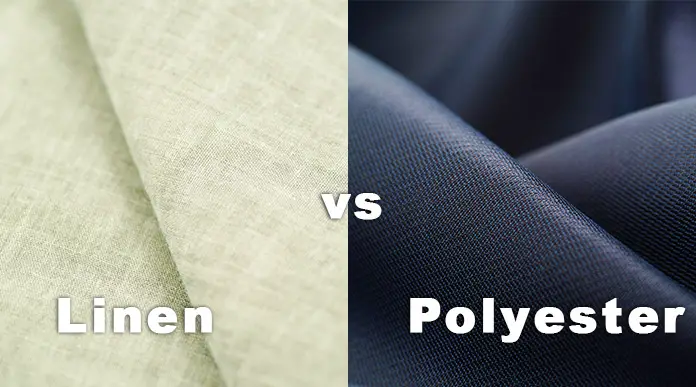The usual topic of debate occurs when we talk about which fabric is best and what is the difference between them. Today many natural, synthetic, and natural-synthetic blends are present in the market. It sometimes becomes hard to distinguish between them without proper knowledge. So, today We pick the two fabrics or fibers from the list and know the difference between them(Linen vs Polyester).
Table of content
- Linen and Polyester
- Linen vs Polyester; Table
- physical properties of linen vs polyester
- chemical properties of linen vs polyester
Linen
One of the oldest textile fabrics in the world has its historic roots which take us back to a thousand years back, it is not completely known when was linen first used as a fabric.
Linen is a natural fabric, obtained from stems of one of the oldest cultivated plant flax. Fabric is made from the cellulose fibers inside the flax plant.
The flax plant grows once a year. You can expect to harvest the flax plant in just 100 days. Similar to other plants flax plans demands regular watering and care. When it grows around 4feet, then it is a sign that the plant is ready to be cultivated.
The reason the flax plant is used in obtaining linen hides in its strong fibers which provides strength to the fabric. Besides linen fabric flax plant is also is rich in dietary fiber and Omega 3 fatty acids.
But to obtain the best quality fabric and seed oil from the plant the two distinct varieties are being harvested. To obtain the best fabric it is a must to harvest the plant before it is fully grown. But for seeds, the plant is not harvested till it is fully mature.
When the stem turns yellow and the seed brown, the plant is ready to be harvested and obtaining a good quality fiber.
Polyester
Fabric is made by using polyester yarns and fibers. Polyester is a man-made synthetic fabric that usually refers to PET (polyethylene terephthalate).
This is one of the most widely used textile fabrics all around the world to make budget-friendly clothing materials.
Some polyester fibers are derived from plants, but most of the polyester is synthetic, made using ethylene.
Because most of the polyester is non-biodegradable, makes it a chemical, harmful to the environment. As per surveys use of polyester contributes to increasing pollution worldwide.
In clothes, polyester is used by blending with cotton or any other fabric to reduce the cost of the material.
Linen vs polyester
Linen and polyester are very distant from each other. Of course, the main reason being one is natural and the other is manmade. But does it really affect the quality of the fabric or material it is used in? Well, let’s know this with basic steps first, and then talk about some technical parameters of these fibers.
Durability
Because derived from plant linen fabric is more durable than polyester.
Weight
linen one of the lightest fabric in the textile industry makes it a comfortable fabric. On the other hand, polyester is light but not much as linen.
Breathability
Because of lightweight, linen lets the air flow through the fabric, makes it the most breathable fabric, and the first choice for warm days.
Polyester is not breathable as linen and blocks the air to flow through the fabric, usually best for normal days with low temperatures.
Recycling
linen is easy to reuse fabric just like other natural fabrics. On the other hand, polyester is hard to reuse because of its rich chemical properties.
Shrinkable
linen is highly shrinkable, mostly when the fabric is new.
So, always buy the extra size if you buy any linen material. Polyester holds very good and doesn’t shrink after regular washes.
Blends
linen polyester blend is the only blend linen favors. On the other hand, polyester can be easily blended with other natural fibers.
Wrinkles
linen wrinkles easily and adjust according to the body movement. But it is not considered as a flaw, instead, wrinkle is what is now a trademark that people usually buy it for.
Polyester is wrinkle-free and remains clean for a long period of time.
Cost
linen is the natural and oldest high-quality fiber which also puts it above the normal price range, but it is not costly.
Polyester is the cheapest of all fabrics and is usually very budget-friendly. However, polyester’s cost depends more on what type of blend it is.
| Characteristics | Linen | Polyester |
| Feel
|
Feels crisp. Change into the soft fabric after regular use. | Feels soft, smooth, and shiny |
| Best for
|
Linen is best for hot warm days | Polyester is best for normal days when the heat is not high. |
| Wrinkles
|
Linen wrinkles easily | Remains wrinkle-free |
| Durability
|
Durable and strong natural fiber | Durable, more than blended fabrics |
| Shrinkable
|
Linen shrink easily after few washes | Does not shrink easily |
| Quality
|
High Quality because of less thread counts. | Quality is not high |
| Cost
|
Linen is an expensive fabric. More expensive than cotton | Cheap and budget-friendly |
| Blend
|
Linen/Rayon, Linen/cotton, Linen polyester | Polyester can be blended with most of the natural fibers. |
| Absorption
|
Linen absorbs moisture easily without holding bacteria | Absorbs less moisture |
| Resiliency
|
Poor | Good |
| Versatility
|
Linen is a versatile fabric | Polyester is also versatile |
| Caring
|
Require extra care | Easy going
|
You may like- Best Fabric for Formal Trousers
You may like- Bomber Jacket vs Puffer Jacket
Physical properties of linen vs polyester
Tensile strength – Tensile strength is the amount of weight or stretch the material or fiber can handle.
usually polyester is a strong fiber with a tensile strength of 2.5 grams/den to 10.5 grams/den.
If we talk about linen, it is strong fiber but not as much if you compare it with polyester. Linen has a tensile strength of 5.5 grams/den to 6.5 gram/den.
Elongation at break – It is the ratio of the change that happens when the fabric is free and when it is stretched, to know the changes in fibers or fabric without any breakage. Usually, natural fibers have more elongation at break ratio than chemical synthetic fibers.
Linen is the natural fiber obtained from the flax plant, has a good elongation at break from 2.7% to 3.5%.
Moisture regains – It is the amount of moisture the fiber or material contains in weight. And when the material’s weight is measured on dry heat, the result in Percentage is known as moisture regain.
Linen has a moisture regain of around 10-12%. On the other hand, polyester has the lowest moisture regain among all fibers. It has a moisture regain of 0.4% and moisture content of 0%.
The formula used to calculate the moisture regain is = [R= M÷D ×100].
Let’s see it through an example- let’s take M as a water weight in material, and D is the dry weight of the material.
The percentage you get after putting the values in the formula is moisture regain.
Specific gravity
The specific gravity of the fiber usually indicates the density of water at 4°C. It indicates how heavy is the fiber. If the fiber has high specific gravity then it means it is a heavy material.
The specific gravity of linen is 1.50. on the other hand, polyester has 1.38 specific gravity.
You may like- Peacoat vs Trench coat vs Overcoat
Chemical properties of linen vs polyester
Acids – linen is not good with acids as it will get completely damaged when coming in contact with high dense acids. Although it (linen) can tolerate normal acids to some extent.
Polyester is a synthetic fiber made with chemicals and does not get affected when coming in contact with high dense chemicals.
Bleaching agents- linen is a good bleaching agent, does not get affected by cool chlorine bleaching agents. On the other side, polyester does not perform well with bleaching agents and degrades the fiber.
Alkalis- Usually, linen does not get affected by alkalis. It has high resistance properties. Polyester is affected by alkalis, result in a weight loss of fabric.
Dyes- Linen is not suitable to dye normally. It only supports vat dyes.
Microorganism- Linen fabric is attracted to bacteria, and can be easily attacked by bacteria or fungi on hot humid days.
Polyester fabrics are coated with AgNps, show rich antibacterial properties for a limited amount of washes.









